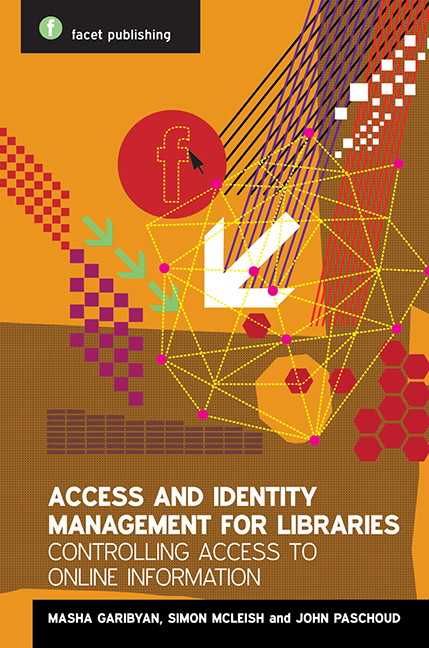Book contents
- Frontmatter
- Contents
- Foreword
- Acknowledgements
- Note to readers
- Glossary
- 1 What is access management, and why do libraries do it?
- 2 Electronic resources: public and not so public
- 3 Principles and definitions of identity and access management
- 4 Current access management technologies
- 5 Authentication technologies
- 6 Authorization based on physical location: how does the internet know where I am?
- 7 Authorization based on user identity or affiliation with a library: who you are? Or what you do?
- 8 Federated access: history, current position and future developments
- 9 How to choose access management and identity management products and services
- 10 Internet access provided by (or in) libraries
- 11 Library statistics
- 12 The business case for libraries
- Afterword
- Appendix 1 Case studies
- Appendix 2 A White Paper on Authentication and Access Management Issues in Cross-organizational Use of Networked Information Resources
- Index
12 - The business case for libraries
Published online by Cambridge University Press: 10 September 2022
- Frontmatter
- Contents
- Foreword
- Acknowledgements
- Note to readers
- Glossary
- 1 What is access management, and why do libraries do it?
- 2 Electronic resources: public and not so public
- 3 Principles and definitions of identity and access management
- 4 Current access management technologies
- 5 Authentication technologies
- 6 Authorization based on physical location: how does the internet know where I am?
- 7 Authorization based on user identity or affiliation with a library: who you are? Or what you do?
- 8 Federated access: history, current position and future developments
- 9 How to choose access management and identity management products and services
- 10 Internet access provided by (or in) libraries
- 11 Library statistics
- 12 The business case for libraries
- Afterword
- Appendix 1 Case studies
- Appendix 2 A White Paper on Authentication and Access Management Issues in Cross-organizational Use of Networked Information Resources
- Index
Summary
Implementing a library access management system requires close co-operation between the library and IT services, as well as support from senior management. This chapter looks at the wider benefits of access management within the host organization, opportunities for further development and how to use this information to produce a successful business case.
Introduction
Today, academic libraries are less likely to adopt their own authentication and access solutions than to make use of the existing identity management carried out by the institution of which they are part, which should now be mature enough to support many of a library's requirements. After all, the same consideration which suggested the FAM model in the first place, that resource providers do not wish to carry out IdM and will not be as good at it as the organizations which already need to do it, applies in a modified form to the relationship between library services and the main IdM systems of the institution: the library does not have a good reason to duplicate any of the institution-wide processes which are already carried out. This is essentially the reason that libraries can now be classified principally as consumers of IdM, as discussed in Chapter 9.
This does not mean that there is no role for the library in the institutional management of its identity services. At the very least, the library has a large number of requirements which follow from the way it wishes to use identity data. The library will need to monitor developments in IdM, and ensure that its current needs are still being met, with accurate data in the form needed for efficient library services, whether this is for user access to the library management system or for FAM-based authentication and authorization to electronic resources.
The library is likely to be setting up new services, or new versions of services, and these might well have IdM requirements which are not necessarily being met by existing institutional systems. For example, many institutions in the UK are currently working on implementing research data archives. These have access management needs that may include a requirement for virtual organizations, for researchers at other institutions who are collaborating on projects with local colleagues to be able to access shared material, before, during, and after archiving.
- Type
- Chapter
- Information
- Access and Identity Management for LibrariesControlling Access to Online Information, pp. 139 - 154Publisher: FacetPrint publication year: 2014



